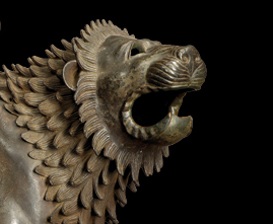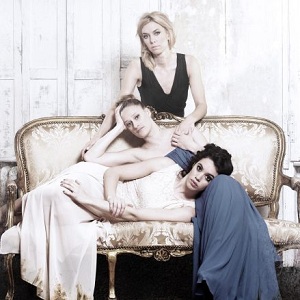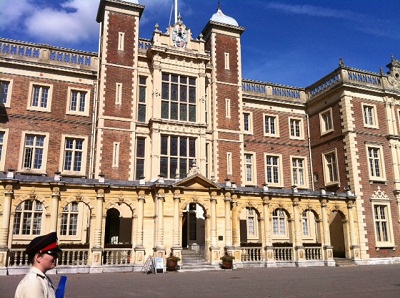
From the moment I stepped into the dimly lit rotunda and stared up at the “Dancing Satyr”, which was so recently pulled from the sea near Sicily by fishermen, I was entranced. The green tint of the metal both hinted at its watery resting place making it look almost like a merman and highlighted the musculature of this strangely life-like piece.
Figures
The exhibition is arranged around themes, which means that ancient appears alongside the new, classical next to modern and Asian and Far Eastern with European. The first gallery is Figures. One moment it’s angular, made-from-bits-and-pieces “Portrait of a Painter” (David Smith, 1954) and the next it’s the smooth sadness of rolled up sleeves in “The Peasant” (Aime-Jules Dalou, 1904).
I was drawn to the powerful, towering figure of “Perseus” (1844, Benvenuto Cellini) and the three glorious figures in “The Pharisee, St John the Baptist and the Levite from The Sermon of Saint John the Baptist” (Giovan Francesco Rustici, 1506), feeling as they were looking directly at me. I was awed at the possible involvement of Leonardo da Vinci.
The alien, lumpy clay-like form of “The clam digger” (de Kooning, 1972) was next to the intricately-detailed and ancient Chinese “Mahasidda Virupa”. Rodin’s “Age of Bronze” (1877) looked so much softer than the other works. In the central glass cases there were sculptures from Nigeria and “Six weepers” from The Netherlands. But in this room the stand out piece for me was the stunningly beautiful simplicity of “The cage” (Giacometti, 1950) – a thin figure holding onto and imprisoned within a cube frame.
In a side gallery I watched some short videos showing different methods of bronze casting and the use of wax and plaster moulds.
Animals
After an inevitable horse’s head there was what looked like an impressive lion – but with a goat and snake on his back it was the Etruscan (400 BCE) “Chimera of Arezzo”. And there was an almost comical Chinese elephant from 1100 BCE. Then a Roman ram from the second century whose expression, woolly coat and horns had the most amazing detail.
In the next room I smiled at “Il Porcellino” and his shiny nose and wondered whether this was the same chap that I had stroked myself a number of times in the market in Florence. I was so happy to see him that I almost missed “Spider IV” (Louise Bourgeois, 1996) on the wall.
Then there was a sturdy “Pug” (Hubert Gerhard, 1600) which raised another smile and a wonderful, if a little bit scary, “Praying Mantis” (Germaine Richier, 1946) amongst various other beasts and birds.
Groups and Objects
I was running out of time so I didn’t spend long looking at riders on panthers, ten figures in “Sculpture, Arithmetic and Architecture” (Berlos, 1732), the four cowboys or the wonderful angel wings in “St Michael overcoming the devil” (Algard, 1647). And whilst a large chest, a pile of nails and a wolf’s head on a beam’s end caught my eye, I didn’t study them in detail.
But I was stopped in my tracks by the stunning wall mounted copper dish (Anish Kapoor, 2012) in which my reflection was inverted. And then I spent ages studying a massive and very detailed Japanese incense burner. And I passed the Reliefs room almost without a glance as I rushed to get into the Gods section.
Gods
The Indian dancing “Shiva Nataraja” with four arms and a snake presided over the entrance. There were lots of Buddhas which reminded me of my recent travels in Thailand. And there was a small figure of Venus (so smooth and dark it looked like polished dark wood) and a tall Bacchus (Soldani Benzi). But my favourite here was “Emaciated Buddha” – obviously before he discovered “the middle way”.
Heads
The heads and busts were much as you would expect and they are not really my thing, although I did take a good look at “Damned Soul” (Benzi) – which is the image used on the exhibition’s promotional material.
But I shall remain eternally grateful to the American gentlemen who saw me looking with puzzlement at “Points of View” by Tony Cragg and pointed out the various face profiles that you can see by walking around what appears to be random stacks of rounded disks. Simply brilliant.
It runs until 9th December - http://www.royalacademy.org.uk/exhibitions/bronze/


